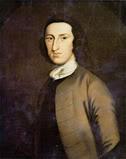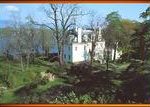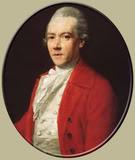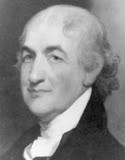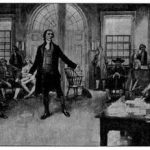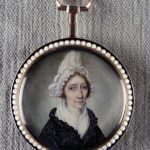Wife of First United States Chief Justice John Jay
Sarah Van Brugh Livingston was born in 1756 to Susannah French Livingston and William Livingston, patriot and first governor of the State of New Jersey. She was educated at home in penmanship, English grammar, the Bible, and classic literature. Sarah grew into a graceful and capable young woman.
At a time when women were usually relegated to the kitchen, she was brought up to be politically aware, even serving at times as her father’s secretary. William Livingston moved his family to a new home, Liberty Hall, in Elizabeth Town, New Jersey, in 1772. Sarah’s beauty, gaiety, and intelligence attracted many suitors.
Sarah chose John Jay, an upcoming young lawyer, and married him at Liberty Hall on April 28, 1774. John Jay was born in New York City on December 12, 1745. His only formal education was received at King’s College, now Columbia University. After graduating, Jay read law, and became a successful lawyer in colonial New York. In 1768, after being admitted to the New York bar, Jay established a legal practice with Robert Livingston, and worked there until he created his own law office in 1771.
Despite the difference in their ages — he was 29, she was 18 — this was a love-match. The couple’s hopes for a peaceful life together were almost immediately shattered by developments that led to the American Revolution. Sarah Livingston Jay was a strong support to her husband, astutely networking with the movers and shakers of the time.
The happy marriage of John and Sarah Jay produced six children: Peter Augustus, born in Elizabeth, New Jersey, in 1776; Susan, born and died in Madrid after only a few weeks of life, in 1780; Maria, born in Madrid in 1782; Ann, born in Paris in 1783, William and Sarah, born in NYC in 1789 and 1792 respectively.
As you can see by the birthplaces of these children, their parents played active parts of the struggle for independence, doing what needed to be done, wherever it needed to be done, at the end of a colonial era and the birth of a new nation. John Jay held a greater variety of posts than any other Founding Father, posts he insisted he did not seek but felt it his duty to his country to assume.
John Jay was elected to the First Continental Congress only months after marrying Sarah. Public responsibilities frequently separated him from his young bride. The newlyweds remained in touch through letters, John addressing Sarah as Sally, and she addressing him as Mr. Jay. Both agonized over the separations, which continued intermittently for years.
At first, Jay sided with those who wanted reconciliation with Britain. Events such as the burning of Norfolk, Virginia, by British troops in January 1776 pushed Jay to support independence. With the outbreak of war, he worked tirelessly for the revolutionary cause and acted to suppress the Loyalists (Americans who sided with the British). Thus Jay evolved into first a moderate and then an ardent Patriot, once he decided that all the colonies’ efforts were fruitless and that the struggle for independence was inevitable.
Upon learning that John had been elected President of the Continental Congress in 1778, ensuring he would be away from her even more, Sarah Livingston Jay wrote him in exasperation, “I am very solicitous to know how long I am still to remain in a state of widowhood.”
On September 27, 1779, Jay resigned his office as President of the Continental Congress and was appointed Minister to Spain. Sarah, having been assured by her husband that “my happiness depends on your welfare,” agreed to accompany him to Europe. The trip took Sarah across a great ocean from her parents, her siblings, her friends, and most painfully, from her little son Peter, who had been born in January, 1776.
After being nearly shipwrecked on their voyage, the Jays arrived in Spain, where they were to remain for more than two years. It was a difficult time: John Jay was not received as Minister of the United States by the Spanish government, and Sarah suffered the loss of an infant daughter, Susan. Sarah gave birth to a second child, Maria, in Madrid in 1781.
Spain refused to recognize American Independence until 1783, fearing that such recognition could spark revolution in their own colonies. Jay, however, convinced Spain to loan $170,000 to the US government.
In 1782, the British were ready to discuss the terms of peace with the Americans. Benjamin Franklin summoned John Jay to Paris to help negotiate a treaty with England, and the Jays gladly left Spain in May 1782.
In France, Sarah came into her own. She had another daughter, Ann, and was happy in a circle of friends that included Franklin and the Marquis de Lafayette and his wife Adrienne. She attended concerts and the theater, and met many of the most notable people of the day.
In 1783, the Treaty of Paris was signed, ending the Revolutionary War. The final treaty dictated that Britain would acknowledge the United States as independent and would withdraw its troops, in exchange for the United States ending the seizure of Loyalist property and honoring private debts, but left many border regions in dispute, and many of its provisions were not enforced.
The Jays returned to New York in 1784, learning upon their arrival that John had been appointed US Secretary for Foreign Affairs. As the wife of the nation’s chief diplomat, Sarah put on elegant dinners for government and foreign dignitaries nearly every week. Drawing upon her European experience as well as her instinctive charm, she quickly came to be regarded as New York’s most glamorous hostess.
Sarah’s greatest passion remained her family. She was as devoted a daughter and mother as she was a wife. While separated from her parents in Europe, she had written her sister:
I had the pleasure of receiving a letter from Mama the other day that was dated in April – I’ve often experienced the truth of an observation I’ve heard from her that Children rarely know the extent of their obligations to their parents until they become parents themselves; and I’m sure I am more sensible than ever of what I owe to mine, since being my distance from them deprived of their advice, and sometimes when most necessary, of their consolation; I have learnt the real value of those blessings…
Of her young children Sarah wrote, “As to my little Prattlers, I had rather hear the music of their tender voices than the united melody of all the birds in the country.”
John Jay did not attend the Constitutional Convention, but joined Alexander Hamilton and James Madison in aggressively arguing in favor of the creation of a new and more powerful, centralized but balanced system of government.
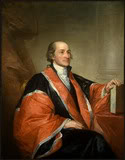
Image: Chief Justice John Jay
Jay wrote five of the Federalist Papers (he was too ill to write more), which were to be used as a guide to the debates concerning the Constitution. He was then nominated and confirmed as the first Chief Justice of the Supreme Court of the United States, a position he held from 1789 through 1795.
In 1794, relations with Britain again verged on war. British exports dominated the US market, while American exports were blocked by British trade restrictions and tariffs. Britain still occupied northern forts that it had agreed to surrender in the Treaty of Paris. President George Washington sent John Jay to London to negotiate with the British the treaty that bears his name.
Sarah remained behind to care for their youngest children, who now included William (born 1789) and Sarah Louisa (born 1792). In John’s absence, she also managed the family’s financial and domestic affairs, overseeing the purchase and sale of stocks and of land, directing improvements to their property at Bedford in Westchester County, New York, and keeping informed about the political scene.
While absent, Jay was elected Governor of New York – serving from 1795 to 1801. Upon her husband’s return to the US, Sarah’s hope for retirement was again deferred when John Jay was elected to two terms as governor. She assumed the duties of New York’s First Lady with her accustomed grace and charm.
As leader of the new Federalist Party, Jay became the state’s leading opponent of slavery. His first two attempts to pass emancipation legislation failed in 1777 and 1785, but the third succeeded in 1799. The new law he signed into existence eventually saw the emancipation of all New York slaves before his death.
While John was finishing his gubernatorial term, the Jays developed the farm at Bedford as the place they would live out their lives together. Sarah told John:
Our Jaunt to Bedford has furnished your daughter and myself with a great many pleasing hopes …In the country I feel ever sensible of an ever present deity dispensing light and life and cheerfulness around, and my heart is animated with confidence and joy and love.
In 1801, John Jay finally retired from politics. Of all the Founding Fathers, none had served his country in as many capacities as he did. When asked by John Adams to return to the Supreme Court, Jay declined. He devoted the remainder of his life to the Episcopalian church and the antislavery cause.

Image: John Jay Homestead
The land where John Jay lived his later years was purchased in 1703 by his maternal grandfather. By 1800, Jay had acquired 750 acres of property near Bedford, New York. In 1799, he began construction of a 24-room farmhouse.
Construction of the main house at Bedford was completed in December 1801. Sarah joined John there, after a delay caused by a bout of ill health. At long last, after 27 years of marriage, Sarah and John Jay could finally devote themselves to each other and their children, without John’s public responsibilities drawing them apart.
Sarah loved the farm and wrote, “I can truly say I have never enjoyed so much comfort as I do here.” Her health had been in decline for several years, however. She had long suffered from attacks of rheumatism, intermittent fevers, and influenza. Only months after moving to Bedford, she became ill again.
On May 28, 1802, Sarah Livingston Jay died suddenly, at the age of forty-six. Sarah’s death changed the lives of the Jay children. Ann took her mother’s place as hostess and manager of daily life at Bedford, and she was very capable. Her gardening skills were legendary.
The death of his beloved wife was a blow from which John Jay never recovered. He never remarried, and lived as a gentleman farmer, focusing on his family, his church, and his farm. The household increased after his son William married and had six children. Surrounded by his children and grandchildren, John Jay died May 16, 1829, at the age of eighty-three.
It is no wonder that the Jay children were raised with the welfare of their country and of those less fortunate in their hearts and minds. None of the Jay children played important national roles, but they exerted significant influence as public servants in furthering the legacy of the Founding Fathers.
SOURCES
Jay’s Treaty
Wikipedia: John Jay
Papers of John Jay
Patriot Lady: The Life of Sarah Livingston Jay
The Amiable Children of John and Sarah Livingston – PDF FILE

